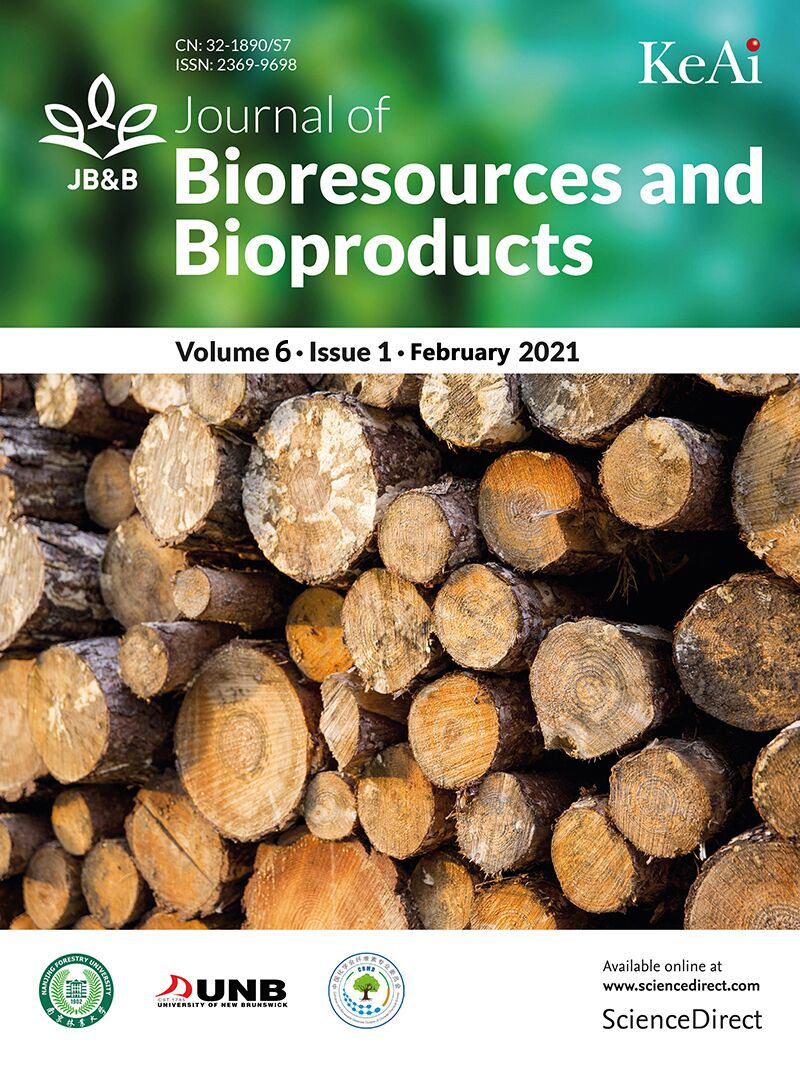2016年 1卷 第2期
China is a significant atmospheric carbon dioxide producer. Burning of agricultural waste in China is also a problematic issue, raising environmental and carbon-emission-related concerns. Furthermore, the coal-dependent economy is accompanied by the formation of large coal mine goaf areas, particularly in Shanxi Province. In this context, the idea of filling crop residues into the coal mine goafs is proposed. This concept addresses multi-functions:(1) carbon sequestration, (2) an alternative disposal method of crop residue in rural areas, and (3) coal mine goaf remedy.
Cellulose is abundant in nature, with the advantages of low-cost, biodegradable and biocompatible, low density and high strength. However, the development and application of cellulose has been lagging behind its potential due to its unique properties. Cellulose has a large quantity of hydroxyl groups which can easily form hydrogen bond networks. The huge hydrogen bond network makes it extremely difficult to dissolve or melt cellulose, thus limiting the effective use of cellulose resources. To dissolve cellulose, the key is to break the hydrogen bonds. This article sums up recent studies on the dissociation or breakage of the intramolecular and intermolecular hydrogen bonds in the dissolution of cellulose.
Surfactant residues in recycled wood fiber from the deinking process can have impact on the subsequent bleaching and papermaking processes by increasing bleaching agents and disturbing papermaking wet-end chemistry. In this paper, the fundamental mechanism of surfactants adsorption characteristics on secondary fiber surface was studied. The adsorption isotherms and kinetics of an anionic surfactant, sodium dodecyl benzene sulfonate (SDBS) and a non-ionic surfactant, Triton X-100 (TX-100) on secondary fiber surface with or without the presence of electrolytes (Mg2+ ions) were studied by using spectrophotometric methods. Results showed that the adsorption isotherm of SDBS could be subdivided into four regions, and the adsorption of SDBS was increased with the presence of Mg2+ ions. While for TX-100, the adsorption isotherm showed typically Langmuir-type adsorption, and its adsorption was decreased with the presence of Mg2+ ions. Kinetic analysis indicated that the adsorption processes both fit pseudo-second-order model well. The adsorption rate of both surfactants was affected by the initial surfactant concentration, electrolyte and temperature. The activation parameters confirmed that the adsorption processes of both surfactants were typically diffusion-controlled and endothermic at a temperature range commonly used for current flotation deinking processes. SDBS and TX-100 mainly adsorbed to the hydrophobic sites of secondary fibers surface, which decreased the fiber hydrophobicity and reduced the fiber loss in the flotation deinking process. The results suggested that the concentration of Mg2+ ions should be maintained at a low level when SDBS was used in the flotation process.
Banana/orange composite wine was brewed in the lab by liquid fermentation using angel yeast and lactic acid bacteria as the fermentation strains, and characterized by chemical analyses. It was found that the best ratio of banana juice to navel orange juice was 1:2, and the optimum alcohol fermentation parameters were as follows:28~30℃, 22% initial sugar content, 6% yeast, and 6 days of fermentation to reach an alcohol concentration of 11.63% v/v. The free amino acids in the composite wines were tested by automatic amino acid analyzer, and the flavor components of the composite wine were determined and analyzed by gas chromatography-mass spectrometry (GC-MS). Seven types of trace elements in the composite wine were measured by atomic absorption spectrometry. Results showed that there were 17 free amino acids, and their total concentration was up to 897.6 mg/L. A total of 16 key compounds were identified in the composite wine, 11 of which were ester, 4 of which were alcohols and 1 of which was acid. Magnesium, iron, copper and manganese elements were relatively rich in the wine, while lead was extremely low.
A facile process to prepare self-reinforced antibacterial paper (SRAP) was developed by in situ synthesis of zinc oxide (ZnO) in partially dissolved cellulose. The SRAP was fabricated by impregnating filter paper in zinc chloride (ZnCl2) solution and then reacting with sodium hydroxide (NaOH). Filter paper was firstly impregnated with ZnCl2 solution of 65 wt% concentration for 5 seconds at 80℃, and then pressed at 3.85 kPa for 5 seconds to remove excess liquid. Subsequently, the paper was soaked in a 0.8 wt% NaOH solution for 1 hour, and then washed with deionized water, and dried finally to yield SRAP. Energy dispersive X-ray spectroscopy (EDS), X-ray photoelectron spectroscopy (XPS) and scanning electron microscope (SEM) were used to characterize the SRAP. The results revealed that the SRAP contained intact cellulose fibers as the skeleton, gelled cellulose as the matrix, and clusters of nano ZnO particles as the filler. The SRAP had a much higher density, tensile and burst strength, compared with the untreated cellulose paper, and the folding strength was enhanced by more than fifteen times. In addition, the SRAP had outstanding antibacterial properties due to the presence of nano ZnO particles.
Chemical, morphological and anatomical characteristics of Cyperus flabettiformic were evaluated. It is characterized with low α-cellulose (32.2%) and moderate lignin (24.0%) content. Fiber length of C. flabettiformic was shorter (0.94mm) but slender ratio was extremely high (166). Anatomically, this grass is constituted by homogeneous parenchyma cells and the vascular bundles (11.8%). Delignification of C. flabettiformic was carried out by conventional soda pulping under varying alkali charge, time and liquor to material ratio at the boiling temperature. Total pulp yield was 55.0% with kappa number 15.5 at the cooking conditions of 12% alkali charge, 2 h of cooking and liquor to material ratio 10:1. Multivariate data analysis was used to evaluate the influence of alkali charge, cooking time and liquor ratio on pulp yield and kappa number. Alkali charge had a significant effect on pulp yield and kappa number. PLSR model showed better prediction efficiencies for pulp yield and PCR model performed better prediction for kappa number. Initial drainage resistance and papermaking properties of C. flabettiformic pulp were higher than other nonwood.
The solubility of beech wood cell wall in 8% lithium chloride/dimethyl sulfoxide (LiCl/DMSO) was investigated with an ethylenediamine (EDA) pretreatment without ball milling. EDA pretreatment of the wood cell wall was found to be an efficient method for the solubilization of the majority of the wood cell wall while avoiding the destructive effects of milling on the structure of the wood cell wall components. The yield of the final insoluble fraction was only approximately 31.6% based on the original Wiley wood sample after two EDA pretreatments and the dissolving processes. The solubility of lignocellulosic material in 8% LiCl/DMSO increased with decreasing lignin content after an EDA pretreatment. The yield of the insoluble fraction decreased from 62.9% to 9.2% with a decrease of lignin content from 28.0% to 14.1%. When the lignin content of lignocellulosic material was relatively low (approximately 10.5%), it could be dissolved in 8% LiCl/DMSO after an EDA pretreatment. The EDA pretreatment of wood meal had a much greater effect on polysaccharides than on the lignin in wood cell wall.
Chemi-thermo-mechanical pulping (CTMP) wastewater has high chemical oxygen demand (COD), which inhibits the activity of microorganisms during biological oxidations. Conventional wastewater treatment technologies such as dissolved air flotation, coagulation, and biological treatment, are insufficient to treat the CTMP wastewater to meet the environmental requirements. There remains a need for advanced wastewater treatment technologies, which can be integrated into existing wastewater treatment processes to improve the end-of-pipe water quality. In this study, a heterogeneous electrochemical oxidation process was developed to treat chemi-thermo-mechanical pulp mill wastewater. The Ti substrate anodes were prepared by thermal decomposition and electro-deposition, and characterized by SEM and Tafel curve. The impacts of electrode modification, flowrate, current density, and aeration on the process efficiency were investigated. COD and color density were used to evaluate the removal efficiency of organic pollutants. Results show that the Ti/SnO2+Sb2O3+MnO2/PbO2 electrode exhibited the best performance in terms of COD and color removal efficiency. SEM observation revealed that the electrode surface was smooth and compact, with numerous uniform micro pores of which the inner walls were covered with tiny crystals. Under the studied conditions, color removal reached 90%, while COD removal was about 60%.






 WeChat: JournalBandB
WeChat: JournalBandB